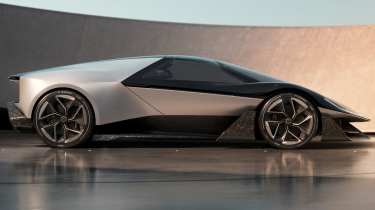Lotus Theory 1 concept is a three-seat, 986bhp hypercar
With Veyron power, a carbon tub and EV underpinnings, the Lotus Theory 1 is more junior Evija than Emira successor
This is the Lotus Theory 1, a new electric-powered concept that’s the biggest statement of intent from the reinvented sports car brand since the Lotus Evija ushered in its Geely-owned era. Not only does the Theory 1 preview a super sports car but it’s also Lotus’s opening gambit for a new design manifesto, called The Lotus Theory.
First, the car. The Theory 1 may have half the Evija’s power but it has more in common with the hypercar than the Emira, Evora or Lotus sports car that’s come before. The Theory 1 is the first sub-Evija Lotus sports car to dispense with the bonded and extruded aluminium structure for which the company is well known, instead employing a (recycled) carbonfibre tub. Inspired by the Lotus 49, it also uses its motor and battery assembly as stressed members in the car’s structure, the pullrod rear suspension and active wing being mounted to this instead of a subframe.
The power and performance are more akin to a hypercar’s than what we’re familiar with from a traditional Lotus too. Even with half the Evija’s output it still has 986bhp. That’s fed to all four wheels, though it’s unclear whether it uses two or four motors. The battery is a 70kWh unit (compared to the Evija’s 93kWh battery), while range is a WLTP-certified 250 miles, identical to the Evija’s. Happily, as a result, the Theory 1 is lighter than the Evija. Though no precise figure has been given, it’s said to be under 1600kg.
The Theory 1 can do 0-62mph in under 2.5 seconds, on the way to a 198mph top speed. Curiously, the the car also features steer-by-wire, like the Eletre, though it’s unclear whether there’s a backup column too.
There’s also been a big sustainability push in the Theory 1, with Lotus reducing the number of ‘A-surface’ materials down from the average of 100 used by a typical new car to just 10. As such, the futuristic-looking bodywork is made of cellulose composite and polycarbonate, with other lightweight, durable, recyclable materials such as titanium and aluminium also incorporated. Even the glass is sustainable, with the greenhouse being made of recycled glass.
What about the styling? There’s certainly some distance between it and the Evija, which at this point is a five-year-old design. It’s definitely identifiable as a relation of the Lotus Emeya and Lotus Eletre, with quite a bit of ’70s, almost Gandini-esque wedge going on. Lower down, there’s a lot of airflow management taking place beneath the car, fed through those exposed carbon elements.
In terms of its dimensions, the Theory 1 is actually as wide as and longer than the Evija, though it is taller by 18mm. In spite of its physical breadth, novel reverse-opening wrap-over doors ensure a small footprint with the doors open, meaning ingress and egress in tight spots should be easier than with other sports cars of its kind.
Open those doors and peer inside and you realise the Theory 1 is quite unlike any Lotus that’s come before, Evija included. That’s because it’s a three-seater, with the driver in the middle and a passenger seated further back on either side, McLaren F1-style. Unconventional for Lotus this may be, but when it comes to the Theory 1 cabin, that’s only where the weirdness begins.
Let’s talk Lotuswear, a proprietary system that immerses the occupants with personalised experiences. For the driver, this means inflatable elements in the seating and even steering wheel, that do their thing in real time to improve support, grip and deliver subtle prompts. When you need to take a left, for instance, the left side of the wheel will pulse. The seats can adapt for use in Tour mode versus Track mode, varying comfort and support. Lotus has developed this in tandem with wearable robotics company MotorSkins.
KEF binaural audio is also integrated into the 3D-printed lattice carbon headrests on the seats and can deliver bespoke soundscapes and ‘speed’ sounds. It also features noise-cancelling tech.
Lotuswear also includes that OLED band running inside and outside the car that can deliver messages to the driver as well as other road users and pedestrians. It’s also an homage to the ‘joining band’ on the Lotus Esprit. The Theory 1 uses Nvidia Drive computing to integrate the Lotuswear system and the 360-degree, quad-LiDAR, six-camera exterior monitoring system that, yes, can also allow it to drive autonomously. Needless to say, the whole user experience is very sci-fi.
So what’s The Lotus Theory, then? Well, it comprises three core principals: Digital, Natural and Analogue, or DNA – get it? Ben Payne, Lotus Group vice president of design, explains: ‘With Theory 1 we’ve built on everything Lotus has achieved so far in its 76-year history, to push the boundaries for what it means to drive a performance vehicle.
‘We want to demonstrate that you don’t need to compromise – with both digital and analogue capabilities working harmoniously in the future car. In doing this, we are able to bring drivers the best possible immersive driving experience, with raw emotion, functionality and connectivity at the core.’
How all of this will translate to a future Lotus production model, we’ll have to wait and see.











